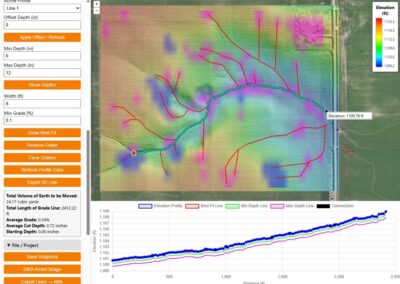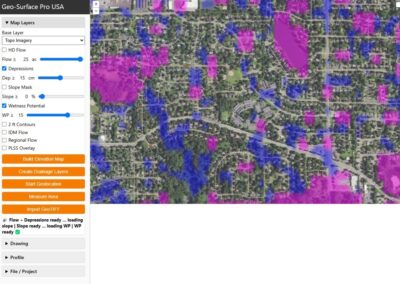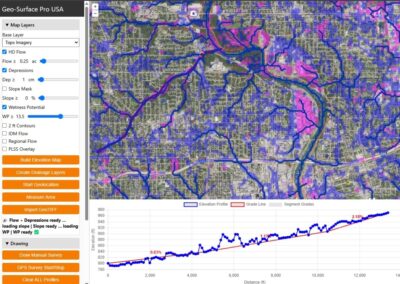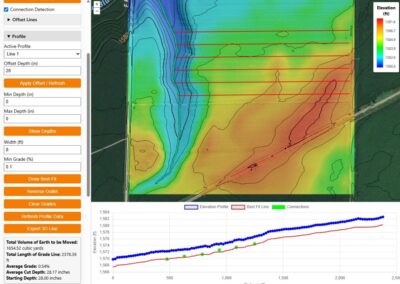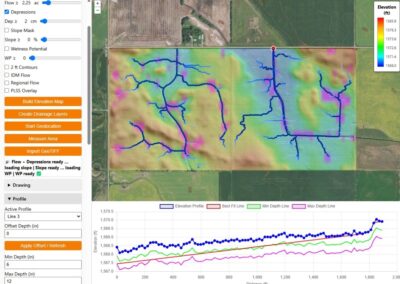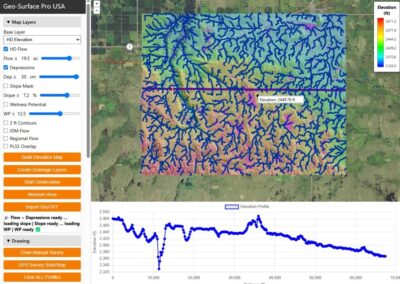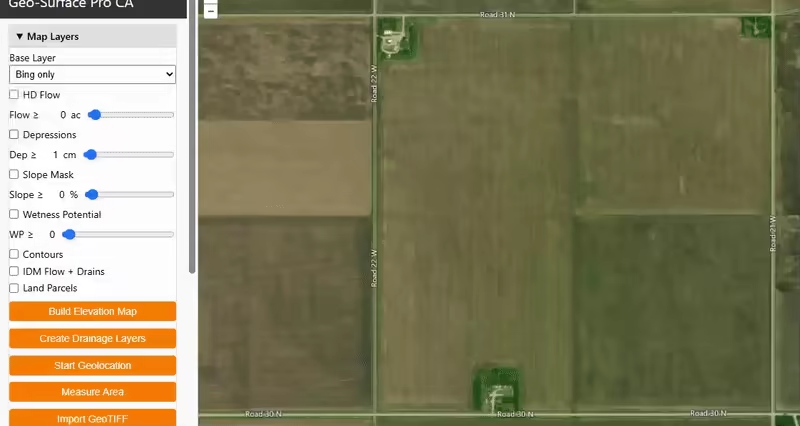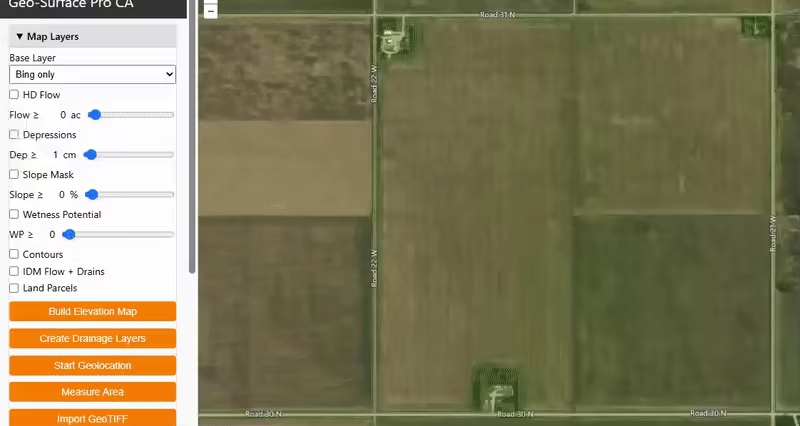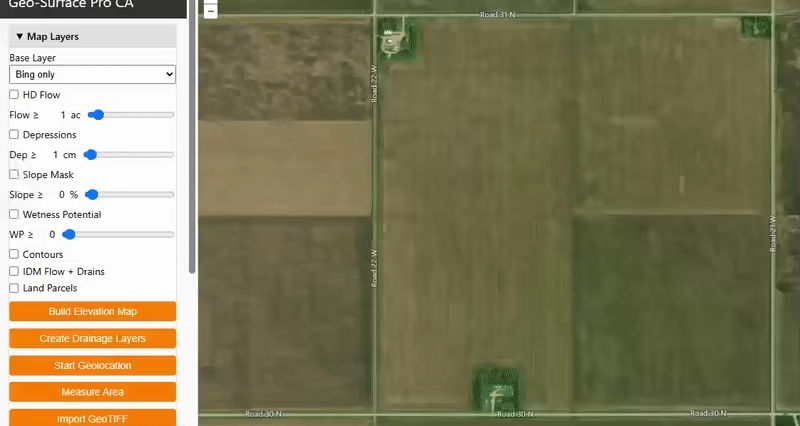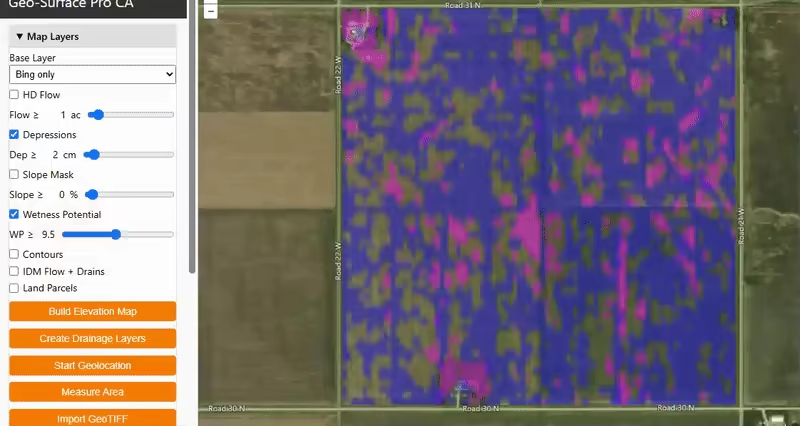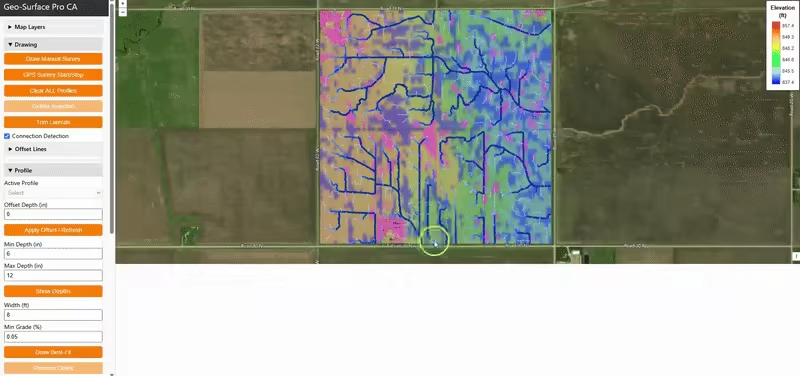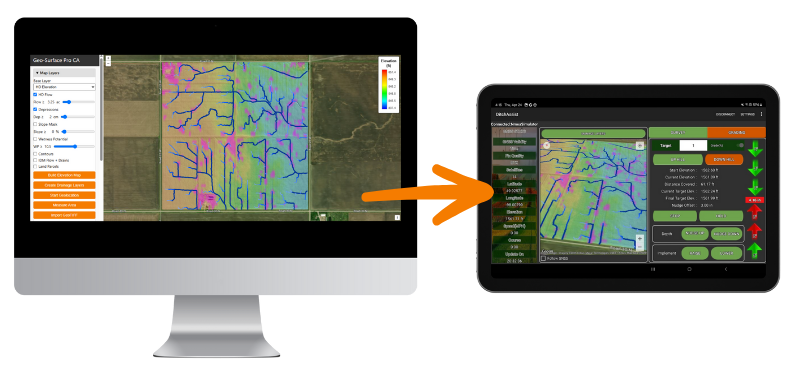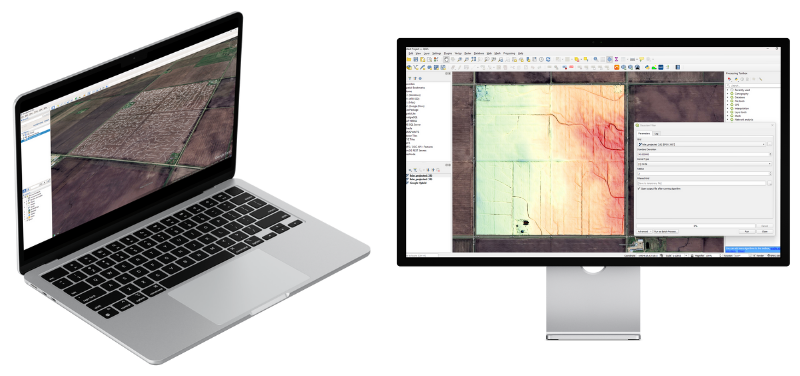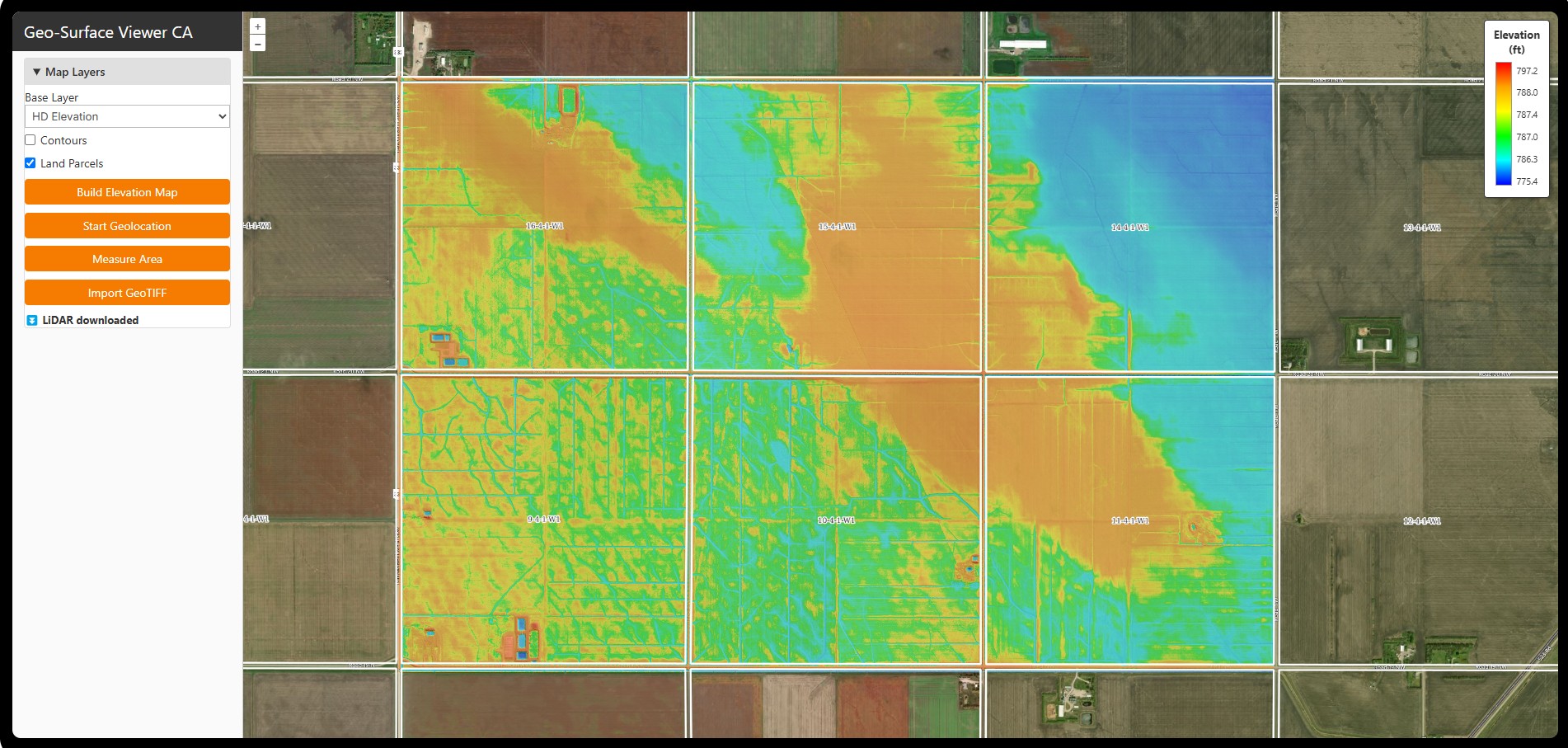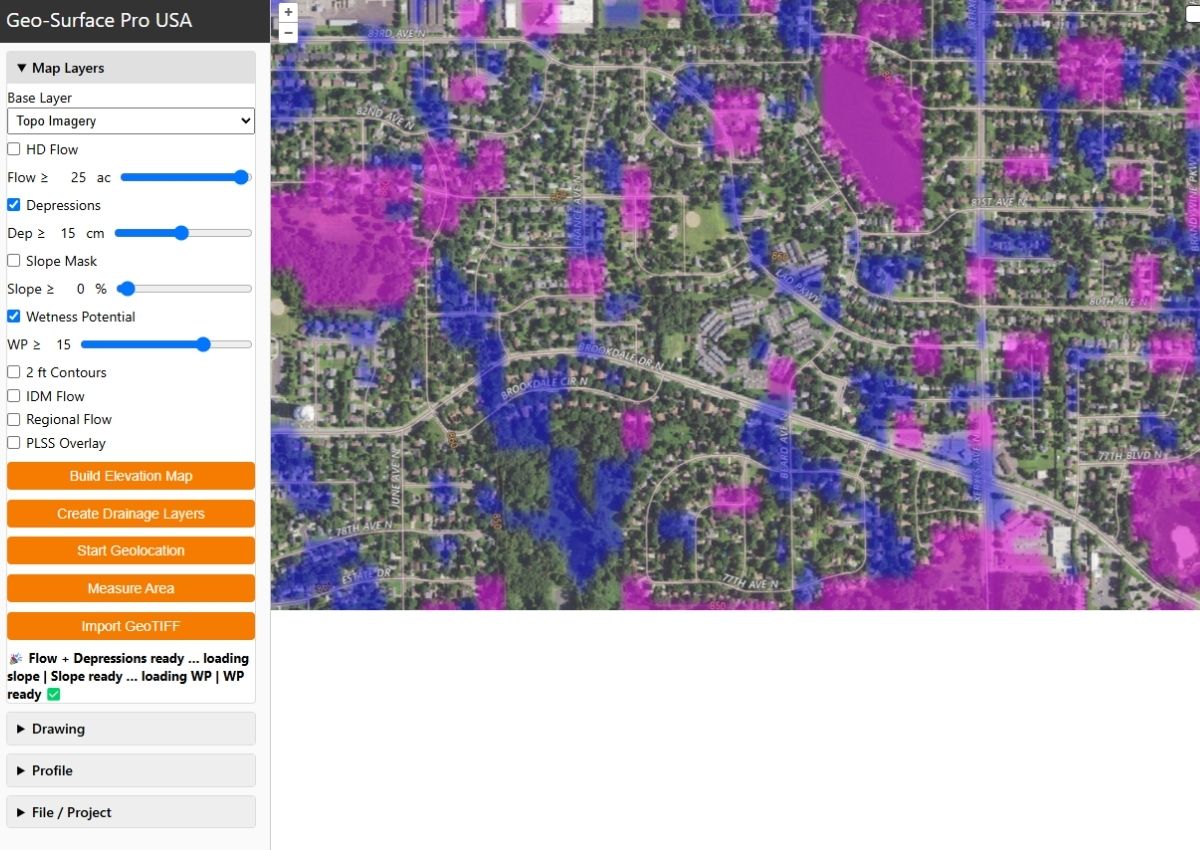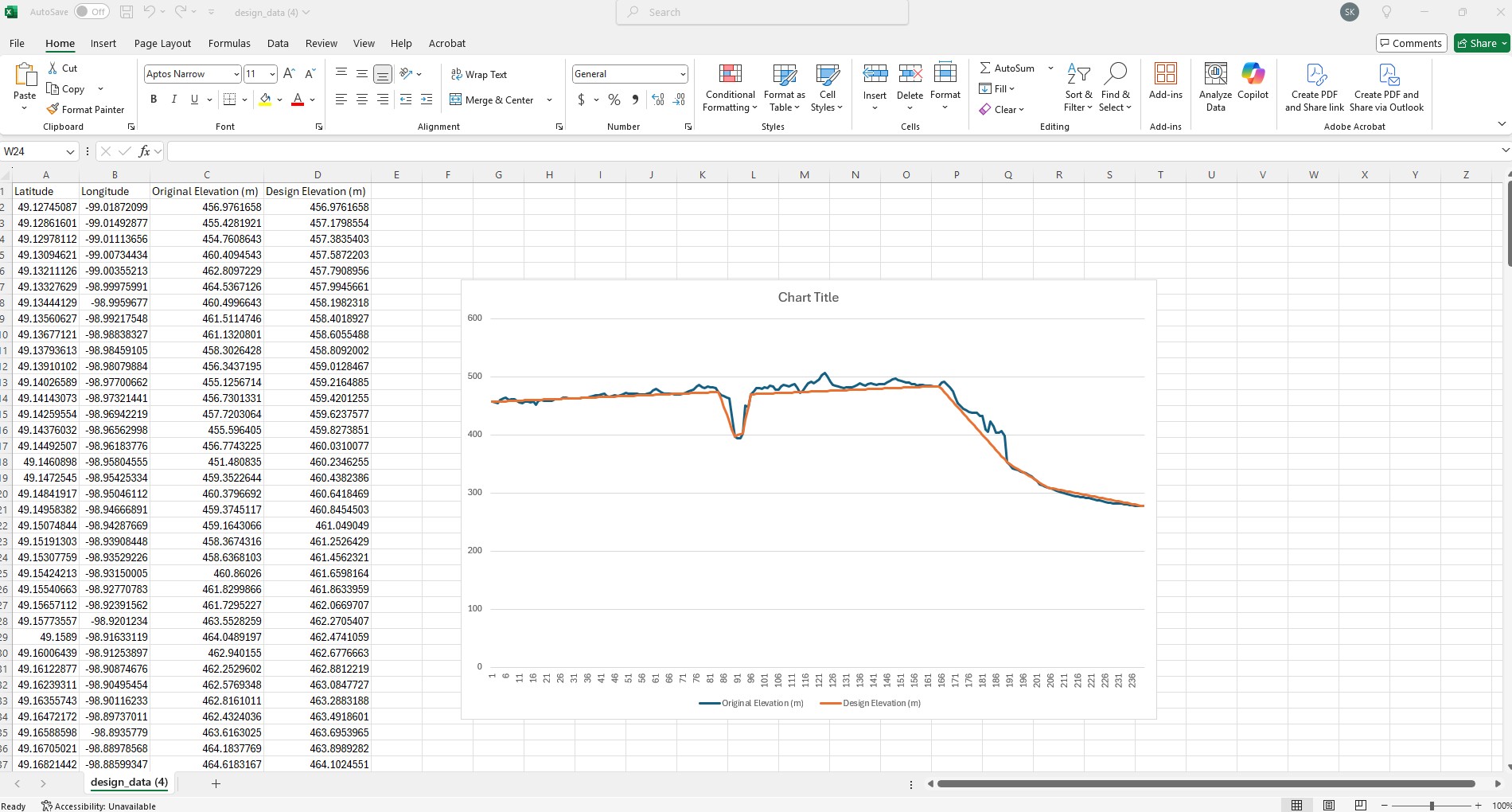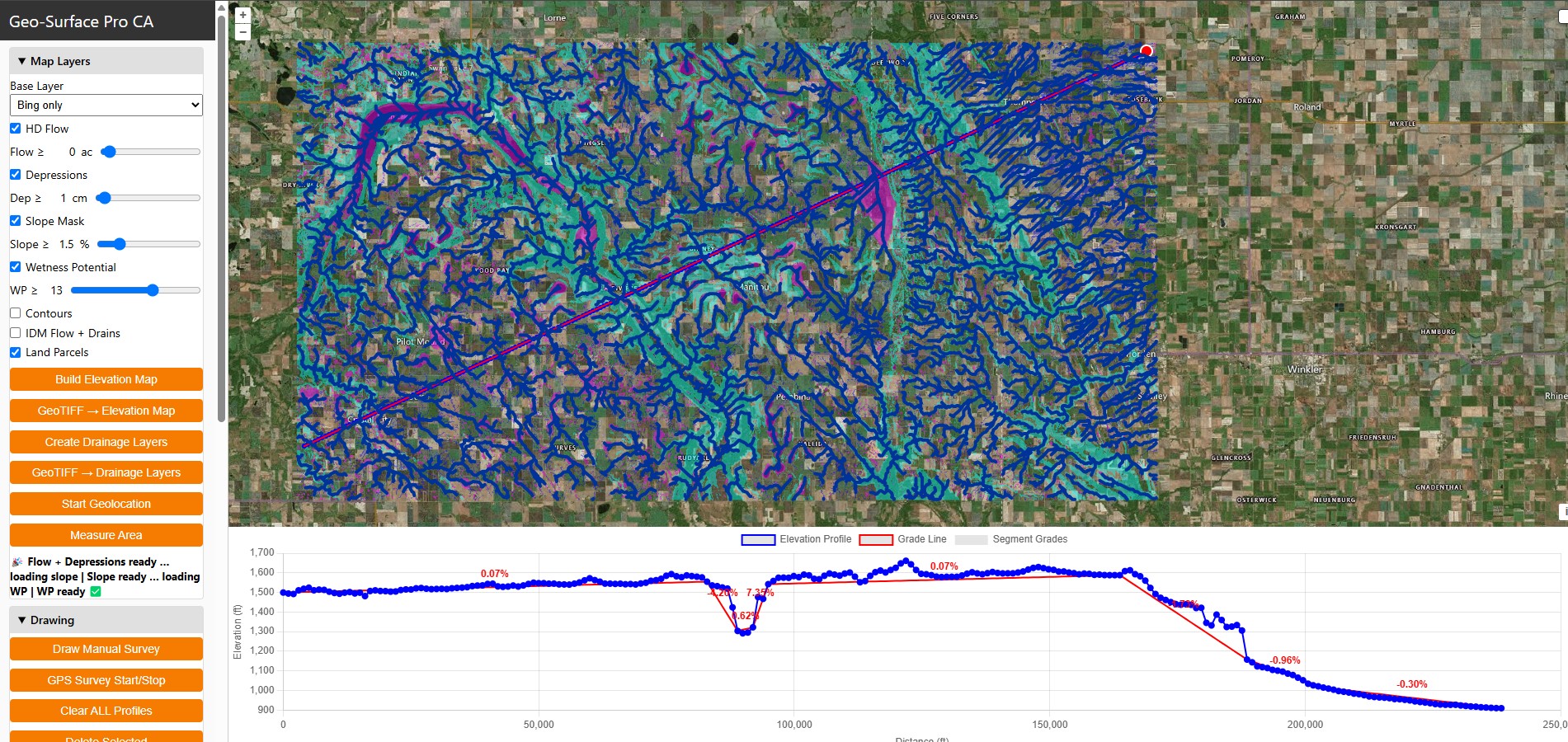View Accurate Field or Land Elevations Anywhere. Instantly — No Signup Needed
Click anywhere in the U.S. or Canada to get accurate LiDAR elevation in seconds. No login, no downloads. Just free access to elevation data.
Click the buttons below to access the free Canada and USA Elevation Mapping Viewers
🟢 Free, Unlimited, and No Signup Required.
Geo-Surface Free Viewer Features
🗺️ Click to view LiDAR-based elevation
🌈 Draw and render stunning 3D terrain maps
📐 Measure acres or trace field outlines
📱 Works on any device (phone, tablet, laptop)

Looking for More Features? Upgrade to Geo-Surface Professional
Geo-Surface Pro is built for power users who need more than just elevation.
It adds advanced drainage mapping layers, full drainage design tools, and support for importing and exporting data and map files—all in the same easy-to-use web browser interface as the free version.
You get features that normally cost thousands in desktop software—for just $499/year per region (currently available regions are US and Canada).
Map Fields or Entire Regions—Up to 1 Million Acres at a Time
Generate Advanced Drainage Layers, Elevation Profiles, and Design Drainage Systems for Any Land Area—Big or Small
Wherever LiDAR elevation coverage is available (that’s virtually all of the U.S. and expanding areas of Canada), simply draw around a field, property, or custom area of interest to create multiple high-resolution drainage mapping layers in under 2 minutes.
🚀 Now supporting areas up to one million acres at a time!
Map massive regions in a single request. Capture major flow routes, significant slopes, key depression zones, and general wetness potential areas over massive areas all in your web browser with a few clicks. Export generated layers for further analysis in GIS software.
For field-level mapping (quarter sections, sections, or custom-sized fields), Geo-Surface delivers highly detailed, high-resolution outputs—showing flow paths, depressions, slope variations, and wetness potential down to partial-acre precision.
Whether you’re mapping 80 acres or 800,000, Geo-Surface scales to your needs—giving you the critical terrain insights to plan projects, manage drainage and water, and identify key terrain and relief features like never before.
Prefer to order by Phone?
Call Northern Plains at +1-877-354-2899 ext. 1
On-Demand Drainage Flow Mapping
At any location with LiDAR elevation coverage (that’s all of the US and these areas for Canada), drawing around a field or land area AOI allows you to automatically generate multiple advanced drainage mapping layers.
NOW YOU CAN MAP UP TO ONE MILLION ACRES AT A TIME!
HD Flow is a high-resolution flow mapping layer that shows you exactly how water moves over the land. This is your secret weapon for effective drainage planning! Adjusting the slider let’s you see how many acres drain to each flow route segment at the field level, easily identifying not only the best drain placement routes, but also where the most important drains are. On larger regions, you’ll see major flow paths, and you can always export the computed flow in KML for deeper anaylsis in GIS software.
Field Depression Mapping
The Depressions map layer (created at the same time as HD Flow) shows you depressional areas within the field or landscape. These are sinks, or low-lying areas that have no natural drainage. Using the on-screen slider, you can adjust the view to see only deeper depressions as required, up to 30cm / ~1ft (export to your GIS software for more detailed analysis). When combined with the HD Flow map, this is often all that is required to export into grade control software like Ditch Assist™ to show you exactly where to make your drains for the most effective surface drainage – remember, whatever you see on the map you can export that view and overlay it on the map in Ditch Assist!
Slope Mask Layer
As you move the slider for the Slope Mask layer, the first areas that become transparent are the flattest parts of the field or project area. As you continue advancing, you’ll be left with only the steepest slope regions highlighted. In addition to helping you identify steep areas with high erosion potentials and the best sites for grassed waterways, this layer can also be used to identify the most level sites within an area for future construction and other projects. And, like all the other generated layers, it can be exported for further anaylisis in GIS software when required.
Wetness Potential Mapping
Wetness Potential shows you the areas that are most prone to waterlogging, but not necessarily classified as depressions. When moving the slider from right to left, the first areas highlighted are likely the first that will become waterlogged based on flow and slope characteristics of the land. Wetness potential helps you identify parts of the field that may require more effective drainage, and can be particularly useful when designing tile drainage systems to help identify which areas might require tighter tile spacings.
Users are also applying wetness and depression mapping in residential areas, helping identify homes built on moisture-prone terrain—often linked to basement water issues.
Advanced Drainage Design Tools
Geo-Surface Pro delivers advanced surface and tile drainage design tools—just like high-end desktop software, but in your browser.
Draw or GPS a proposed drain route to instantly view the terrain profile. Add a best-fit or constant-grade line to simulate how your machine control will perform in the field.
See estimated start depths, cubic yards to move, and check grades at a glance. Use connection validation to ensure every lateral joins the main correctly—whether it’s tile or surface drainage.
Go to the field with a plan—not a guess.
Export What You See, Use It Where You Need
Geo-Surface Pro runs entirely in your web browser, so it works seamlessly on any device.
Design drainage systems on your PC or Mac, then open the same project on your phone or tablet in the field—where built-in geolocation helps you follow and stake out your runs with precision.
Easily save and resume drainage design projects anytime.
Need a quick reference layer? Instantly export map images showing whatever’s on your screen—including flow routes, elevation, or design lines—perfect for importing into Ditch Assist™ or other mapping tools.
Works with QGIS, ArcGIS, Google Earth & More
With Geo-Surface Pro, your data is yours to keep.
Need the LiDAR you’re viewing in QGIS or ArcGIS? Just one click and it’s downloaded to your hard drive. Export flow routes as KML files—ready for use in any GIS software or for easy viewing in Google Earth or Google Earth Pro. Want to import your depressions layer into QGIS? No problem, just save it to your hard drive! Likewise with the slope and wetness potential layers you generate. It’s your data, you own it!
And we’re constantly expanding what you can generate and export, with new layers and features added regularly.
From Flow Mapping to Full Design and Data Export—It’s All in Pro
$499/year
Prefer to order by Phone?
Call Northern Plains at +1-877-354-2899 ext. 1
Get the Most out of Geo-Surface Pro
Controls and Common Workflows Explained
Generate HD Elevation Layer
Click Build Elevation Map, draw a polygon around your area of interest, and double-click to finish. In seconds, you’ll see a colorized LiDAR-based HD elevation overlay with 3D hillshading.
The overlay’s resolution adapts to selection size:
- Small areas (under a quarter-section) render at ~1 m/pixel or finer in most areas.
- Large regions (state-sized) render at ~100 m/pixel or more.
In Canada, HD overlays require LiDAR coverage (in the US it should work everywhere). If you encounter a 500 error, the server is likely busy or under maintenance—wait a few minutes and retry. Evening or weekend disruptions usually clear within an hour or by the next morning.
To download the raw DEM you’re viewing, click Save LiDAR WGS84 under File/Project. This exports a GeoTIFF in EPSG:4326 (WGS84) with elevation in meters.
For non-LiDAR areas or custom data, import your own GeoTIFF using GeoTIFF → Elevation Map (GeoTIFF must be using EPSG:4326 WGS84 coordinate system with elevation in meters) to build the HD overlay. See our video tutorial for formatting guidance.
Create Drainage Layers
Click Create Drainage Layers, then draw around your area of interest just as you would when generating an HD elevation map. Geo-Surface will download LiDAR at a similar resolution (higher resolution for smaller areas), upload it through your browser to a cloud-based GIS server for processing, and automatically download the resulting flow, depression, slope, and wetness layers back into your session.
Once the Drainage Layers are generated, you can download the raw LiDAR DEM in a projected CRS (EPSG:3857 Web Mercator) using the Save LiDAR EPSG:3857 button under File/Project.
Because the processing server requires projected DEM files (such as 3857), the system works in projected coordinates for analysis. However, for easier mapping and compatibility, the resulting depression, slope, and wetness potential layers are converted back to WGS84 (EPSG:4326) when downloaded back into Geo-Surface, so when you export any of these layers they will be in WGS84 CRS.
You may also upload your own GeoTIFF to generate the same Drainage Layers using the GeoTIFF → Drainage Layers button. Your GeoTIFF must be under 6 MB in size and use a projected CRS like UTM Zone x or EPSG:3857.
Drainage Flow Mapping
The HD Flow layer is generated using TauDEM’s StreamNet output, which is then converted to KML for display in Geo-Surface and for download via Export Flow → KML.
For smaller areas like fields, you can adjust the minimum contributing area shown using the slider. At 0 acres, all flow lines will be visible—including very minor tributaries. As you slide to the right, smaller, less significant tributaries are filtered out, showing only larger flow paths.
On larger regions, most flowlines already exceed 25 acres of contributing area, so the slider may not have much visible effect.
The exported KML file includes all original StreamNet attributes, allowing you to further analyze the flow network in GIS software if needed.
Depression Mapping
Depression areas are computed by subtracting the elevation of a pit-filled (depressionless) DEM from the original raw elevation DEM. Wherever a depression was filled, the result is a negative value representing the depth of the depression in meters.
Geo-Surface converts these values to centimeters for easier visualization. To provide smoother and less spotty coverage, depression layers are resampled to 30 m pixels if the original DEM resolution is finer than 30 meters.
Using the slider, you can control which depressions are shown—starting from all depressions and progressively filtering out shallow areas up to >30 cm deep.
When you download the depressions layer, you’ll get the full depression depth data (>30 cm), ready for further analysis in any GIS software.
Geo-Surface automatically converts these values to centimeters for easier visualization. Using the slider, you can control which depressions are shown—starting from all depressions and filtering out shallow ones up to >30 cm deep.
When you download the depressions layer, you’ll get the full set of depression depths greater than 30 cm, which you can analyze further in any GIS software.
Slope Mask Layer
The Slope Mask layer is a simple pixel-based slope calculation, expressed in percent (%), derived directly from the raw DEM. For smaller areas of interest, the slope layer is resampled to 30 m pixels to smooth out small fluctuations and eliminate noise from minor elevation variations.
Keep in mind that raster-based slope and profile tool slope are calculated differently.
- Raster slope is based on elevation changes between each pixel and its immediate neighbors.
- Profile tool slope measures elevation change along a line between selected points, not based on neighboring pixels.
As a result, slope values you see in the raster layer may differ slightly from the slopes shown in elevation profiles along drawn routes.
Wetness Potential Mapping
The Wetness Potential layer is based on a classic Topographic Wetness Index (TWI), calculated using TauDEM outputs and resampled to 30m for smaller regions for smoothing. It combines local slope and flow accumulation derived from a depressionless DEM to highlight areas more prone to wetness or waterlogging—even if they are not formal depressions.
Since depressions are filled before wetness is computed, true depressions usually don’t show up in the Wetness Potential layer itself. To identify the wettest areas more completely, combine the Wetness Potential and Depressions layers. Depressions will flood first, followed by the low-lying areas that appear as you move the Wetness Potential slider from right (high threshold) to left (lower threshold).
Note that soil type and texture are not considered here, so wetness potential may be less accurate on lighter, sandier soils.
Drawing Tools
Use Draw Manual Survey to trace a proposed drain route directly on the map. An elevation profile of the underlying terrain will appear below the map as you draw. This can be done with or without first generating the HD Elevation layer, although without it, fetching elevation values from the LiDAR server may take a few seconds.
If you're in the field, you can also use your mobile device’s GPS to walk or drive a proposed route. Elevation values are still fetched from LiDAR (not from your device’s GPS altimeter), and the profile will appear the same way as if drawn manually.
To quickly check grades between points on the profile, simply click two or more points. A grade line will snap between them, showing the slope for each segment you select.
To trim the ends of any drawn profile lines, use Trim Laterals and draw a line that cuts through them to create two new line features. The shortest of the two will be automatically deleted.
Use Copy (Offset) Line to create an exact copy of the seleceted profile line, offset either left or right when standing at the outlet looking toward the inlet end. Up to 5 offsets can be created at a time.
Profile Tools
The Active Profile dropdown lets you select the line you want to work on. When you add grade lines, depth offsets, and other edits to a profile, its state is saved and recalled when reselected.
To add depth (e.g., simulating tile installation or deepening a surface drain), enter a value in Offset Depth, then click Apply Offset / Refresh. The red grade line will shift to the new depth.
Use Min Depth and Max Depth lines as visual guides. They don’t affect best-fit calculations, but show when your proposed grade goes deeper or shallower than your design targets. For tile designs, typical min/max values might be 24–60 inches for laterals, with mains often requiring deeper minimums.
Width is used to estimate earthworks for surface drainage—adjust it based on the desired ditch bottom width or implement width.
Min Grade is used for Best-Fit design. If the natural slope drops below the min grade, cuts will be made to maintain it. A minimum of 0.1% is typical for tile drainage; lower values are fine for surface drains.
To create a Best-Fit, click two points on the profile (usually outlet and inlet). Geo-Surface assumes the lower point is the outlet, but if needed, use Reverse Outlet to swap the start and end points.
Use Export 3D Line to export the active profile and assigned grade design for use in other applications.
File / Project
The most important habit to maintain when using Geo-Surface is to regularly back up your design projects.
Because all your work is stored only inside your web browser (nothing is saved to external servers), the only way to protect your work against data loss is to create and save Backup files.
Best practice is to create a new backup after any major design changes.
Backup files are very small and will not take up meaningful space on your computer, but they can save you hours of work if something unexpected happens.
.
📂 File and Project Controls Overview:
-
Save Snapshot – Save a simple, high-quality image of the map for quick reference.
-
Ditch Assist Image – Save a georeferenced JPG map and world file for use in Ditch Assist or other mapping software.
-
Export Design → KML – Export your manually drawn and designed drain routes as a KML file for use in GIS or Google Earth.
-
Import Design ← KML – Import previously saved design routes (KML format).
(Note: KMLs only store lines, not full design settings. Always prefer backups for full project recovery.) -
Export Flow → KML – Export generated flow lines (from drainage analysis) as a KML file.
-
Import Flow ← KML – Import a saved KML flow lines file into your current project.
-
Backup Design Project – Save a full backup of your current project, including drawn lines, grade profiles, offsets, width, depth settings, and more.
(Highly recommended before and after major updates.) -
Restore Design Project – Restore a previously saved backup file to instantly reload your work.
-
Save LiDAR WGS84 – Download the raw HD elevation DEM as a GeoTIFF (EPSG:4326 WGS84, elevations in meters).
-
Save LiDAR EPSG:3857 – Download the raw HD elevation DEM in a projected coordinate system (EPSG:3857, Web Mercator).
-
Save Depressions – Download the mapped depressions raster as a GeoTIFF (EPSG:4326 WGS84).
-
Save Slope % – Download the slope raster (% grade) as a GeoTIFF (EPSG:4326 WGS84).
-
Save Wetness Pot. – Download the wetness potential raster as a GeoTIFF (EPSG:4326 WGS84).
Works with QGIS, ArcGIS, Google Earth & More
With Geo-Surface Pro, your data is yours to keep.
Need the LiDAR you're viewing in QGIS or ArcGIS? Just one click and it’s downloaded to your hard drive. Export flow routes as KML files—ready for use in any GIS software or for easy viewing in Google Earth or Google Earth Pro. Want to import your depressions layer into QGIS? No problem, just save it to your hard drive! Likewise with the slope and wetness potential layers you generate. It's your data, you own it!
And we’re constantly expanding what you can generate and export, with new layers and features added regularly.
🌍 About Geo-Surface – Elevation, Terrain, and Drainage Mapping for the USA and Canada
Geo-Surface is a powerful, web-based platform for LiDAR-based elevation mapping, terrain visualization, and drainage design across the United States and Canada. Whether you’re working on farms, fields, rural land, or municipal projects, Geo-Surface makes elevation data accessible and actionable—right in your browser, with no software to install.
With free and Pro versions available, users can instantly:
-
📍 Click to view elevation anywhere in the USA or Canada
-
🗺️ Generate 3D terrain maps using high-resolution LiDAR
-
💧 Identify natural drainage patterns and water flow paths
-
🚜 Design and simulate tile or surface drainage systems
-
📐 Export maps and data to use in GIS tools like QGIS, ArcGIS, or Ditch Assist™
✅ Geo-Surface Viewer – Free for All Users
-
Instantly see LiDAR elevation data with a click
-
Generate high-resolution terrain overlays
-
Measure fields or properties in acres
-
Export map snapshots for reference or reporting
-
Works across most of the U.S. and LiDAR-mapped areas of Canada
🚀 Geo-Surface Pro – Built for Power Users
Geo-Surface Pro adds a full suite of professional-grade tools for users who need more than just elevation:
-
🔁 Generate flow route maps to model water movement
-
🌀 Visualize depressions and wet zones using LiDAR-derived data
-
📈 Analyze slope and wetness potential across fields
-
🛠️ Design and simulate surface and tile drainage systems
-
🔍 Export KML files, georeferenced maps, and raw LiDAR (GeoTIFF)
-
🧠 Use best-fit drain simulations, grade validation, and earthworks estimation
Geo-Surface Pro delivers features typically found in expensive desktop software—for just $49/month or $499/year—all in a browser.
🔎 Perfect For:
-
Farmers planning field drainage
-
Agronomists and consultants creating farm elevation maps
-
Landowners and developers evaluating property topography
-
GIS professionals and students working with LiDAR and terrain analysis
-
Conservation groups modeling runoff, slope, and watershed behavior
🌐 Coverage:
-
USA: Full LiDAR coverage from USGS 3DEP
-
Canada: Expanding LiDAR coverage by province—use the LiDAR Terrain Layer to verify coverage in your area
-
Works with your own GeoTIFF data in any location
Whether you’re checking a single field’s elevation or building a full drainage plan, Geo-Surface puts LiDAR-powered tools into the hands of farmers, planners, and professionals across North America.

